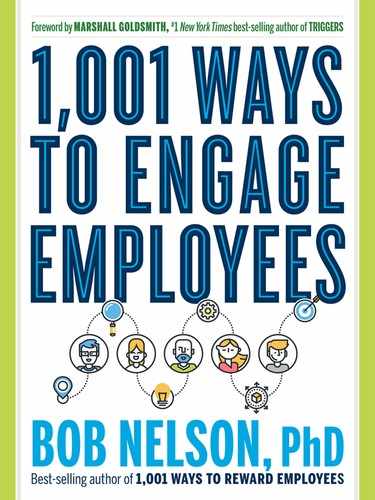WHO OWNS EMPLOYEE ENGAGEMENT?
FOREWORD BY MARSHALL GOLDSMITH
I was delighted when Bob Nelson asked me to do the Foreword for this book. We have spent much time discussing the topic of employee engagement over the years, and I was excited that he was focusing on it, first, because it is sorely needed given how little real progress most organizations have made on truly engaging their employees, and second, because I feel Bob's unique approach of identifying positive, real-life, practical strategies and examples for readers to draw from was exactly what could make the most difference on the topic for both individuals and organizations alike. Whereas I maintain that behavioral change is difficult, Bob consistently reminds us that change can be easier than we might think and is often simply a matter of finding the right idea at the right time to successfully implement. This book will help you do that.
One of the eternal mysteries in the field of talent management is the poor return from American companies' $10 billion investment in programs to boost employee engagement. Part of the problem is that despite the massive spending on surveying, training, and related programs, many companies end up doing things that stifle rather than promote engagement. Why is that? I believe that it's primarily because we frame the problem incorrectly, starting with who should be held responsible on the topic.
WHO OWNS EMPLOYEE ENGAGEMENT?
The standard practice in almost all organizational surveys about employee engagement is to rely on “passive questions,” that is, questions that describe a static condition. “Do you have clear goals?” is an example of a passive question. It's passive because it can cause people to think of what is being done to them rather than what they are doing for themselves.
When people are asked passive questions, they almost invariably provide “environmental” answers. Thus, if an employee answers no when asked, “Do you have clear goals?” the reasons are attributed to external factors such as, “My manager can't make up his mind” or “The company changes strategy every month.” The employee seldom looks within to take responsibility and say, “It's my fault.” Blame is assigned elsewhere. The passive construction of “Do you have clear goals” begets a passive explanation (“My manager doesn't set clear goals”).
The result is that when companies take the natural next step and ask for positive suggestions about making changes to improve things, the employees' answers once again focus exclusively on the environment, not themselves. “Managers need to be trained in goal-setting” or “Our executives need to be more effective in communicating our vision” are typical responses. The company is essentially asking, “What are we doing wrong?”—and the employees are more than willing to oblige with a laundry list of the company's mistakes and shortcomings.
Even if the company improves on what employees want them to do, it's too easy for employees to continue to deflect any responsibility for the behavior and subsequently tell their employers: “It's still not good enough; you've got to do more.” This becomes a no-win approach to the behavior as organizations are forced to chase an ever-shifting impossible dream.
Passive questions set up individuals to shirk personal responsibility and accountability. They can give people the unearned permission to pass the buck to anyone and anything but themselves.
ALL MOTIVATION STARTS WITH THE INDIVIDUAL
How much better to start with each employee as the center of focus, so instead of asking them “Do you have clear goals?” you might ask “What are you doing to assure that your goals are clear?” or “Did you do your best to set clear goals for yourself?” Now the onus is on the employee to take responsibility to create a vision, craft a plan, and take action steps to obtain a better result.
Or take the issue of career development. If we know anything about this topic, it's that all development is self-development. That is, you can have the best skills-training programs, networking opportunities, and career paths, but if an individual isn't motivated to want to make the most of those resources and opportunities, those programs won't help that individual to learn, grow, or advance in his or her job or career.
And likewise for all the engagement categories Bob presents in this book. As you read, discuss, and apply ideas he has collected in your organization, remember to start with the individuals whose behavior you are most trying to impact. Don't just ask “What needs to be done?” but also “Who's willing to help make it happen?” and “What one or two things can everybody do to move us forward in this area?”
This approach will help assure that you're able to truly and more easily improve employee engagement with and for your employees!
—Dr. Marshall Goldsmith,
Rancho Santa Fe, California
